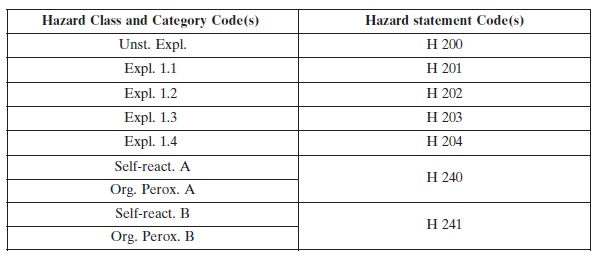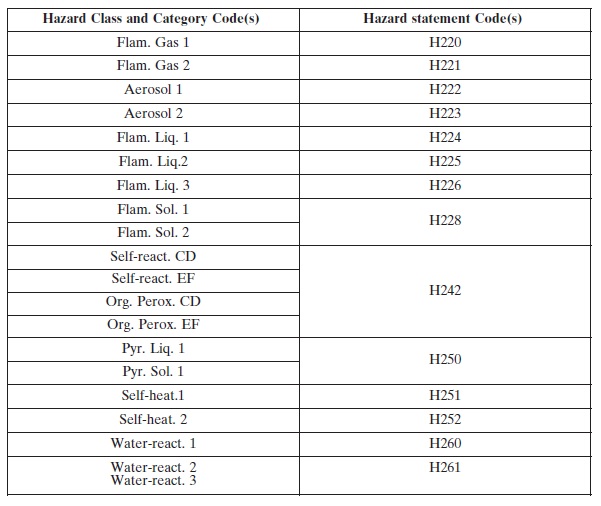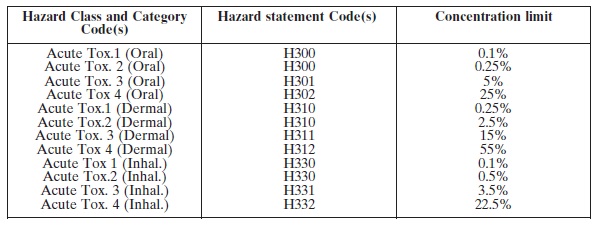Waste Management Act 1996
F312[SECOND SCHEDULE
Properties of Waste which Render it Hazardous
Section 4(1)
HP 1 "Explosive": waste which is capable by chemical reaction of producing gas at such a temperature and pressure and at such a speed as to cause damage to the surroundings. Pyrotechnic waste, explosive organic peroxide waste and explosive self-reactive waste is included.
When a waste contains one or more substances classified by one of the hazard class and category codes and hazard statement codes shown in Table 1, the waste shall be assessed for HP 1, where appropriate and proportionate, according to test methods. If the presence of a substance, a mixture or an article indicates that the waste is explosive, it shall be classified as hazardous by HP 1.
Table 1: Hazard Class and Category Code(s) and Hazard statement Code(s) for waste constituents for the classification of wastes as hazardous by HP 1:

HP 2 "Oxidising": waste which may, generally by providing oxygen, cause or contribute to the combustion of other materials.
When a waste contains one or more substances classified by one of the hazard class and category codes and hazard statement codes shown in Table 2, the waste shall be assessed for HP 2, where appropriate and proportionate, according to test methods. If the presence of a substance indicates that the waste is oxidising, it shall be classified as hazardous by HP 2.
Table 2: Hazard Class and Category Code(s) and Hazard statement Code(s) for the classification of wastes as hazardous by HP 2:

HP 3 "Flammable":
— flammable liquid waste: liquid waste having a flash point below 60°C or waste gas oil, diesel and light heating oils having a flash point > 55°C and ≤ 75°C;
— flammable pyrophoric liquid and solid waste: solid or liquid waste which, even in small quantities, is liable to ignite within five minutes after coming into contact with air;
— flammable solid waste: solid waste which is readily combustible or may cause or contribute to fire through friction;
— flammable gaseous waste: gaseous waste which is flammable in air at 20°C and a standard pressure of 101.3 kPa;
— water reactive waste: waste which, in contact with water, emits flammable gases in dangerous quantities;
— other flammable waste: flammable aerosols, flammable self-heating waste, flammable organic peroxides and flammable self-reactive waste.
When a waste contains one or more substances classified by one of the following hazard class and category codes and hazard statement codes shown in Table 3, the waste shall be assessed, where appropriate and proportionate, according to test methods. If the presence of a substance indicates that the waste is flammable, it shall be classified as hazardous by HP 3.
Table 3: Hazard Class and Category Code(s) and Hazard statement Code(s) for waste constituents for the classification of wastes as hazardous by HP 3:

HP 4 "Irritant — skin irritation and eye damage": waste which on application can cause skin irritation or damage to the eye.
When a waste contains one or more substances in concentrations above the cut-off value, that are classified by one of the following hazard class and category codes and hazard statement codes and one or more of the following concentration limits is exceeded or equalled, the waste shall be classified as hazardous by HP 4.
The cut-off value for consideration in an assessment for Skin corr. 1A (H314), Skin irrit. 2 (H315), Eye dam. 1 (H318) and Eye irrit. 2 (H319) is 1%.
If the sum of the concentrations of all substances classified as Skin corr. 1A (H314) exceeds or equals 1%, the waste shall be classified as hazardous according to HP 4.
If the sum of the concentrations of all substances classified as H318 exceeds or equals 10%, the waste shall be classified as hazardous according to HP 4.
If the sum of the concentrations of all substances classified H315 and H319 exceeds or equals 20%, the waste shall be classified as hazardous according to HP 4.
Note that wastes containing substances classified as H314 (Skin corr.1A, 1B or 1C) in amounts greater than or equal to 5% will be classified as hazardous by HP 8. HP 4 will not apply if the waste is classified as HP 8.
HP 5 "Specific Target Organ Toxicity (STOT)/Aspiration Toxicity": waste which can cause specific target organ toxicity either from a single or repeated exposure, or which cause acute toxic effects following aspiration.
When a waste contains one or more substances classified by one or more of the following hazard class and category codes and hazard statement codes shown in Table 4, and one or more of the concentration limits in Table 4 is exceeded or equalled, the waste shall be classified as hazardous according to HP 5. When substances classified as STOT are present in a waste, an individual substance has to be present at or above the concentration limit for the waste to be classified as hazardous by HP 5.
When a waste contains one or more substances classified as Asp. Tox. 1 and the sum of those substances exceeds or equals the concentration limit, the waste shall be classified as hazardous by HP 5 only where the overall kinematic viscosity (at 40°C) does not exceed 20.5 mm2/s.1
Table 4: Hazard Class and Category Code(s) and Hazard statement Code(s) for waste constituents and the corresponding concentration limits for the classification of wastes as hazardous by HP 5

HP 6 "Acute Toxicity": waste which can cause acute toxic effects following oral or dermal administration, or inhalation exposure.
If the sum of the concentrations of all substances contained in a waste, classified with an acute toxic hazard class and category code and hazard statement code given in Table 5, exceeds or equals the threshold given in that table, the waste shall be classified as hazardous by HP 6. When more than one substance classified as acute toxic is present in a waste, the sum of the concentrations is required only for substances within the same hazard category.
The following cut-off values shall apply for consideration in an assessment:
— For Acute Tox. 1, 2 or 3 (H300, H310, H330, H301, H311, H331): 0.1%;
— For Acute Tox. 4 (H302, H312, H332): 1%.
Table 5: Hazard Class and Category Code(s) and Hazard statement Code(s) for waste constituents and the corresponding concentration limits for the classification of wastes as hazardous by HP 6

HP 7 "Carcinogenic": waste which induces cancer or increases its incidence.
When a waste contains a substance classified by one of the following hazard class and category codes and hazard statement codes and exceeds or equals one of the following concentration limits shown in Table 6, the waste shall be classified as hazardous by HP 7. When more than one substance classified as carcinogenic is present in a waste, an individual substance has to be present at or above the concentration limit for the waste to be classified as hazardous by HP 7.
Table 6: Hazard Class and Category Code(s) and Hazard statement Code(s) for waste constituents and the corresponding concentration limits for the classification of wastes as hazardous by HP 7

HP 8 "Corrosive": waste which on application can cause skin corrosion.
When a waste contains one or more substances classified as Skin corr.1A, 1B or 1C (H314) and the sum of their concentrations exceeds or equals 5%, the waste shall be classified as hazardous by HP 8.
The cut-off value for consideration in an assessment for Skin corr. 1A, 1B, 1C (H314) is 1.0%.
HP 9 "Infectious": waste containing viable micro-organisms or their toxins which are known or reliably believed to cause disease in man or other living organisms.
The attribution of HP 9 shall be assessed by the rules laid down in reference documents or legislation in the Member States.
HP 10 "Toxic for reproduction": waste which has adverse effects on sexual function and fertility in adult males and females, as well as developmental toxicity in the offspring.
When a waste contains a substance classified by one of the following hazard class and category codes and hazard statement codes and exceeds or equals one of the following concentration limits shown in Table 7, the waste shall be classified hazardous according to HP 10. When more than one substance classified as toxic for reproduction is present in a waste, an individual substance has to be present at or above the concentration limit for the waste to be classified as hazardous by HP 10.
Table 7: Hazard Class and Category Code(s) and Hazard statement Code(s) for waste constituents and the corresponding concentration limits for the classification of wastes as hazardous by HP 10

HP 11 "Mutagenic": waste which may cause a mutation, that is a permanent change in the amount or structure of the genetic material in a cell.
When a waste contains a substance classified by one of the following hazard class and category codes and hazard statement codes and exceeds or equals one of the following concentration limits shown in Table 8, the waste shall be classified as hazardous according to HP 11. When more than one substance classified as mutagenic is present in a waste, an individual substance has to be present at or above the concentration limit for the waste to be classified as hazardous by HP 11.
Table 8: Hazard Class and Category Code(s) and Hazard statement Code(s) for waste constituents and the corresponding concentration limits for the classification of wastes as hazardous by HP 11

HP 12 "Release of an acute toxic gas": waste which releases acute toxic gases (Acute Tox. 1, 2 or 3) in contact with water or an acid.
When a waste contains a substance assigned to one of the following supplemental hazards EUH029, EUH031 and EUH032, it shall be classified as hazardous by HP 12 according to test methods or guidelines.
HP 13 "Sensitising": waste which contains one or more substances known to cause sensitising effects to the skin or the respiratory organs.
When a waste contains a substance classified as sensitising and is assigned to one of the hazard statement codes H317 or H334 and one individual substance equals or exceeds the concentration limit of 10%, the waste shall be classified as hazardous by HP 13.
F313[HP 14 "Ecotoxic": waste which presents or may present immediate or delayed risks for one or more sectors of the environment.
Waste which fulfils any of the following conditions shall be classified as hazardous by HP 14:
Waste which contains a substance classified as ozone depleting assigned the hazard statement code H420 in accordance with Regulation (EC) No 1272/2008 of the European Parliament and of the Council (*1) and the concentration of such a substance equals or exceeds the concentration limit of 0,1 %.
[c(H420) ≥ 0,1 %]
Waste which contains one or more substances classified as aquatic acute assigned the hazard statement code H400 in accordance with Regulation (EC) No 1272/2008 and the sum of the concentrations of those substances equals or exceeds the concentration limit of 25 %. A cut-off value of 0,1 % shall apply to such substances.
[Σ c (H400) ≥ 25 %]
Waste which contains one or more substances classified as aquatic chronic 1, 2 or 3 assigned to the hazard statement code(s) H410, H411 or H412 in accordance with Regulation (EC) No 1272/2008, and the sum of the concentrations of all substances classified as aquatic chronic 1 (H410) multiplied by 100 added to the sum of the concentrations of all substances classified as aquatic chronic 2 (H411) multiplied by 10 added to the sum of the concentrations of all substances classified as aquatic chronic 3 (H412) equals or exceeds the concentration limit of 25 %. A cut-off value of 0,1 % applies to substances classified as H410 and a cut-off value of 1 % applies to substances classified as H411 or H412.
[100 Σc (H410) + 10 Σc (H411) + Σc (H412) ≥ 25 %]
Waste which contains one or more substances classified as aquatic chronic 1, 2, 3 or 4 assigned the hazard statement code(s) H410, H411, H412 or H413 in accordance with Regulation (EC) No 1272/2008, and the sum of the concentrations of all substances classified as aquatic chronic equals or exceeds the concentration limit of 25 %. A cut-off value of 0,1 % applies to substances classified as H410 and a cut-off value of 1 % applies to substances classified as H411, H412 or H413.
[Σ c H410 + Σ c H411 + Σ c H412 + Σ c H413 ≥ 25 %]
Where: Σ = sum and c = concentrations of the substances.]
HP 15 "Waste capable of exhibiting a hazardous property listed above not directly displayed by the original waste".
When a waste contains one or more substances assigned to one of the hazard statements or supplemental hazards shown in Table 9, the waste shall be classified as hazardous by HP 15, unless the waste is in such a form that it will not under any circumstance exhibit explosive or potentially explosive properties.
Table 9: Hazard statements and supplemental hazards for waste constituents for the classification of wastes as hazardous by HP 15

In addition, Member States may characterise a waste as hazardous by HP 15 based on other applicable criteria, such as an assessment of the leachate.
Note
F314[…]
Test methods
The methods to be used are described in Council Regulation (EC) No 440/20082 and in other relevant CEN notes or other internationally recognised test methods and guidelines.]
Annotations
Amendments:
F312
Substituted (1.06.2015) by European Union (Properties of Waste Which Render it Hazardous) Regulations 2015 (S.I. No. 233 of 2015), reg. 4, in effect as per reg. 3.
F313
Substituted (27.09.2018) by European Union (Properties of Waste which Render it Hazardous) Regulations 2018 (S.I. No. 383 of 2018), reg. 3(a).
F314
Deleted (27.09.2018) by European Union (Properties of Waste which Render it Hazardous) Regulations 2018 (S.I. No. 383 of 2018), reg. 3(b).
Editorial Notes:
E628
Previous affecting provision: schedule substituted (31.03.2011) by European Communities (Waste Directive) Regulations 2011 (S.I. No. 126 of 2011), reg. 24; substituted as per F-note above.

